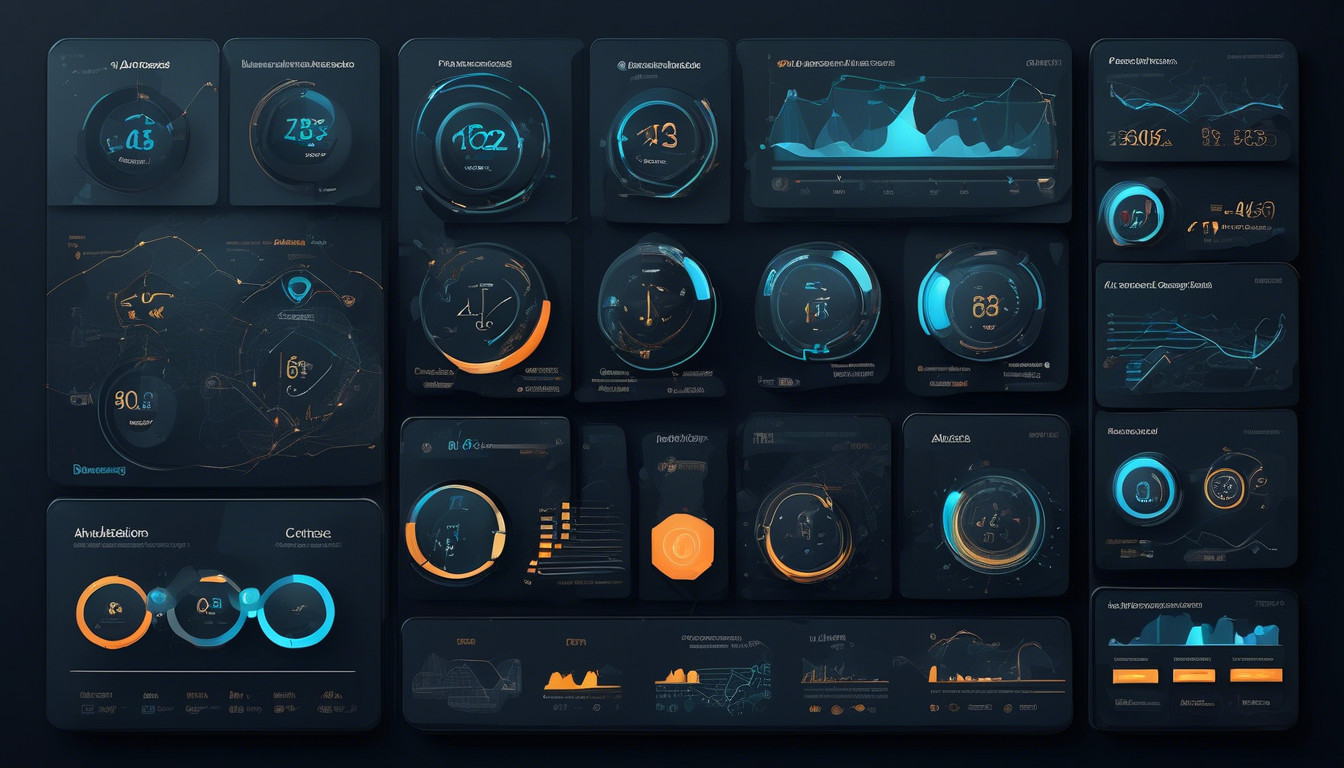
Napisane przez Topcontent/AI
A Beginner's Guide to APIs
In today's digital landscape, we find ourselves increasingly surrounded by a myriad of applications and services that seamlessly connect and communicate with one another. As beginners venturing into the realm of technology, we may often hear the term "API" tossed around, yet it remains shrouded in mystery for many of us.
This guide aims to demystify APIs, unraveling their complexities and demonstrating how they serve as the crucial bridges between software applications. Together, we will:
- Explore the fundamental concepts that underpin Application Programming Interfaces.
- Examine their pivotal role in modern development.
- Provide straightforward examples to illustrate their functionality.
By delving into this guide, we can arm ourselves with the knowledge to navigate the world of APIs with confidence, whether we are aspiring developers or simply curious about how our favorite apps work behind the scenes.
Let us embark on this journey to uncover the power and potential of APIs.
What is an API?
An API (Application Programming Interface) is a set of rules that allows different software applications to communicate with each other. It's a powerful tool that enables seamless integration between diverse systems, granting us the ability to streamline operations and amplify efficiency.
Benefits of APIs:
- By harnessing the power of APIs, we're able to connect disparate platforms, creating a cohesive ecosystem where data flows freely and processes are optimized.
- Imagine integrating various services, from payment gateways to social media platforms, all at our fingertips. APIs grant us this power, allowing our applications to interact like a well-oiled machine.
Security Considerations:
With such power comes responsibility, especially in the realm of authentication. We must ensure that our integrations are secure, safeguarding our data and maintaining trust.
Advantages of Mastering APIs:
- Unlock the potential to innovate rapidly.
- Scale effortlessly.
- Maintain a competitive edge.
In this interconnected world, APIs aren't just a tool—they're our gateway to transforming possibilities into reality.
Why are APIs important?
In today's digital landscape, APIs play a crucial role in enabling seamless communication between diverse software systems. They empower us by creating robust connections, allowing different platforms to integrate effortlessly.
With APIs, we unlock the potential to:
- Automate complex processes
- Share data efficiently
This is essential for businesses aiming to stay ahead in a competitive market.
APIs enhance our power by offering a secure method of exchanging information through strong authentication mechanisms. This ensures that only authorized users and applications gain access, safeguarding valuable data. As a result, we can trust the integrity of our systems while expanding our technological capabilities.
Moreover, by leveraging APIs, we can innovate faster. They provide us with the building blocks to:
- Create new services
- Improve existing ones
- Reduce development time and costs
In essence, APIs are the unsung heroes behind the scenes, driving integration and boosting our capacity to create impactful, cutting-edge solutions in an ever-evolving tech world.

How do APIs work?
At their core, APIs function as intermediaries that allow two applications to communicate and exchange data seamlessly. By facilitating integration, they empower us to harness the power of multiple systems, transforming individual applications into a cohesive ecosystem.
When we implement an API, we gain the ability to access and utilize data from external sources, enhancing our application's functionality and scope.
To ensure secure communication, APIs employ authentication techniques. This step is crucial—without it, data exchange could lead to breaches or unauthorized access. By validating the identity of the requesting entity, APIs maintain the integrity and confidentiality of our data.
We typically use the following methods for authentication, depending on the level of security required:
- Tokens
- Keys
- OAuth protocols
In essence, APIs are the conduits of digital power, enabling us to integrate and amplify our technological capabilities. By mastering API integration and understanding authentication, we unlock a realm of possibilities, driving innovation and efficiency in our digital endeavors.

API vs. SDK
When comparing APIs and SDKs, we find that each serves a distinct role in software development:
APIs:
- Focus on communication between software systems.
- Enable seamless integration by defining how different systems interact.
- Handle authentication to ensure secure access and data exchange.
- Enhance applications' capabilities by leveraging existing services, avoiding the need to reinvent the wheel.
SDKs:
- Provide comprehensive resources, including:
- Libraries
- Documentation
- Code samples
- Empower developers to create robust applications by simplifying complex tasks.
- Often include APIs but extend further by offering a complete toolkit for development processes.
In essence, APIs function as the communication bridge, facilitating integration and secure interactions. Conversely, SDKs serve as the powerhouse toolkit, offering everything necessary to efficiently build and integrate applications.
Together, APIs and SDKs amplify development prowess, ensuring the delivery of top-tier solutions.

Types of APIs
There are several types of APIs available, each designed to address specific needs and use cases in software development.
1. Open APIs:
- Also known as external or public APIs.
- Accessible by any developer.
- Provide a robust way for third-party integration.
- Enhance applications with minimal effort.
2. Partner APIs:
- Require specific rights or licenses.
- Intended for a specific group.
- Offer a controlled environment for integration and collaboration.
3. Private APIs:
- Used within an organization.
- Improve internal processes.
- Boost efficiency by enabling seamless integration between different internal systems.
4. Composite APIs:
- Allow batching multiple API requests into a single call.
- Streamline complex processes.
- Improve performance.
In all cases, authentication is crucial in maintaining security and ensuring that only authorized users can access the APIs. This way, we maintain control and protect our resources.

RESTful APIs
RESTful APIs are a prevalent architectural style for designing networked applications. They rely on stateless communication and use HTTP methods to perform operations.
We harness the power of RESTful APIs to create seamless integration between various services, enabling us to build robust and scalable applications. By leveraging HTTP methods, we can perform precise operations on the resources we need to control, transforming how we interact with web services. The key HTTP methods include:
- GET: Retrieve data from a resource.
- POST: Submit data to be processed to a resource.
- PUT: Update a resource with new data.
- DELETE: Remove a resource.
Flexibility and Simplicity are hallmarks of RESTful APIs. These APIs support various data formats, but JSON often reigns supreme due to its lightweight nature.
When it comes to security, robust authentication mechanisms like OAuth 2.0 ensure our interactions remain secure and trusted. We must prioritize authentication to protect our data and maintain system integrity.
Overall, RESTful APIs empower us to drive innovation and efficiency in our projects, making them essential tools for anyone looking to master API integration and elevate their technological prowess.

SOAP APIs
SOAP APIs offer a structured protocol that allows for complex operations and ensures data integrity across distributed systems. By leveraging the power of SOAP, we can achieve robust integration capabilities that support mission-critical applications demanding reliability and security.
Key Advantages of SOAP APIs:
-
SOAP's XML-based messaging ensures seamless communication between disparate systems while maintaining a high standard of data consistency.
-
Built-in standards for security and authentication allow for strict access controls, ensuring that only authorized users can interact with our systems.
-
SOAP utilizes protocols like WS-Security to encrypt messages and authenticate requests, providing a fortified layer of protection.
Implementation Benefits:
-
Control and Security:
- Enforce strict access controls.
- Ensure that only authorized users have system interaction.
-
Message Security:
- Encrypt messages.
- Authenticate requests using WS-Security.
-
Reliability in Complex Environments:
- Supports complex transactions with guaranteed delivery.
- Features like ACID compliance provide reassurance for operations that can't afford failure.
By harnessing SOAP, we unlock the full potential of our API integrations, ensuring our systems are both powerful and reliable. This makes SOAP an ideal choice for environments where reliability and security are paramount.

GraphQL APIs
GraphQL APIs provide a flexible approach to querying data, allowing us to specify exactly what information we need and receive it in a single request. This power lets us optimize our applications by:
- Minimizing data transfer
- Improving performance
With GraphQL, we're not limited to predefined endpoints; instead, we can craft queries tailored to our needs, making integration with various services seamless and efficient.
In the realm of API integration, GraphQL stands out by enabling us to fetch multiple resources in a single call. This is a game-changer because it:
- Reduces the complexity of making numerous REST API requests
- Decreases the overhead associated with these requests
As we streamline our data retrieval processes, we also handle authentication with ease. GraphQL supports various authentication strategies, ensuring secure access to data.
By leveraging GraphQL's capabilities, we gain the ability to adapt quickly to changing requirements. We're empowered to:
- Build robust applications
- Deliver precise data swiftly
This enhances our competitive edge in today's fast-paced digital landscape.

Public vs. Private APIs
When evaluating APIs, it is important to distinguish between public and private APIs based on their accessibility and intended use.
Public APIs:
- Act as open doors, allowing developers worldwide to access and integrate with a service without much hassle.
- Are ideal for those seeking widespread integration and innovation, enabling rapid expansion and collaboration.
- Require robust authentication methods to ensure security and proper usage due to their great accessibility.
Private APIs:
- Serve as guardians of internal systems, designed for use within an organization.
- Provide significant control over who can access and integrate with them, ensuring that sensitive data and operations remain secure and streamlined.
- Typically involve a more stringent authentication process, maintaining strict control over access.
By understanding the differences between public and private APIs, we empower ourselves to make strategic decisions. This helps in leveraging the right API for our specific needs and maximizing our control over integration processes.

Benefits of using APIs
Harnessing the Power of APIs
Harnessing the power of APIs transforms the way we develop applications, enabling seamless communication between different systems and platforms. With APIs, we gain the ability to connect diverse services efficiently, elevating our projects to new heights. This integration ensures that our applications remain agile and adaptable, ready to meet evolving demands and expectations.
Benefits of APIs
APIs empower us by:
- Streamlining processes
- Reducing redundancy
- Enhancing productivity
They allow us to leverage existing functionalities rather than building from scratch, saving valuable time and resources. By providing a standardized method for communication, APIs simplify complex interactions, giving us the control to focus on innovation and strategic growth.
Importance of Authentication
Authentication plays a crucial role in API utilization, ensuring secure and authorized access to data and services. Through robust API authentication, we protect sensitive information and maintain user trust, which is paramount in today's digital landscape.
Conclusion
Embracing APIs not only strengthens our development efforts but also positions us at the forefront of technological advancement, ready to harness the full potential of interconnected systems.

Common API use cases
Developers across various industries rely on APIs to streamline tasks such as data retrieval, payment processing, and social media integration. By harnessing the power of APIs, we unlock new efficiencies and capabilities.
Data Retrieval:
- APIs allow for seamless data extraction from different platforms with minimal coding.
- This optimizes operations and enhances decision-making processes.
Payment Processing:
- Integrating secure payment gateways through APIs ensures transactions are swift and authenticated.
- This not only maintains our competitive edge but also enhances user experiences by making them smooth and secure.
Social Media Integration:
- APIs enable connections between applications and platforms like Facebook, Twitter, and Instagram.
- This facilitates real-time user engagement, expanding our reach.
- The integration ensures content resonates across networks, boosting brand visibility and influence.
By utilizing APIs, we are empowered to innovate and excel, transforming complex tasks into streamlined processes that amplify our impact.

API authentication methods
When accessing APIs, we must ensure secure and reliable communication by implementing appropriate authentication methods. By doing so, we protect our data and maintain integrity in our integrations. Several robust authentication techniques empower us to control access effectively.
OAuth is a popular method that allows users to grant third-party applications limited access to their resources without revealing credentials. This ensures security and flexibility in API interactions.
API Keys are another powerful method. They are simple yet effective for identifying and authenticating requests. API keys work well for server-to-server communication where simplicity is paramount.
For more advanced security, we can utilize JWT (JSON Web Tokens). JWTs offer a compact and self-contained way of transmitting information, ensuring data integrity and authenticity through digital signatures. These tokens enhance our control over user sessions and permissions.
In our quest for secure API integration, choosing the right authentication method is crucial. By adopting these strategies, we fortify our systems and wield the power of APIs with confidence.

API rate limiting
Managing API Rate Limiting
API rate limiting is crucial for maintaining service stability and preventing abuse by managing the number of requests a client can make to our server.
Key Benefits:
- Resource Availability: Imposing limits ensures that resources remain accessible to all users and are not monopolized by a few.
- System Design: Understanding rate limits is essential for designing systems that handle high volumes without sacrificing performance or reliability.
Core Concepts:
-
Control Over Restrictions: Rate limiting is not merely about restricting access but about maintaining control. We define how many requests are allowed within a specific timeframe to ensure fairness and operational efficiency.
-
Enhanced Security: When combined with robust API authentication, rate limiting is an effective tool for:
- Preventing unauthorized access
- Protecting against threats like denial-of-service attacks
Mastering Rate Limiting:
By mastering API rate limiting, we ensure seamless integration and robust security in our digital interactions. This control allows us to confidently navigate the dynamic landscape of modern technology.

API documentation importance
Comprehensive documentation plays a pivotal role in ensuring developers can effectively understand and utilize an API. When diving into API integration, clear documentation becomes our strongest ally. It equips us with the knowledge needed to seamlessly connect different systems and unlock their full potential.
Key Benefits of Clear Documentation:
- Precise instructions help us master authentication processes.
- Secure applications and protect sensitive data, enhancing control and security.
Effective API Documentation:
- Provides detailed explanations of endpoints, parameters, and response formats.
- Allows developers to foresee potential challenges and address them proactively, saving valuable time and resources.
- Enables the implementation of features with precision, boosting productivity and enhancing project quality.
In the fast-paced world of software development, having thorough and accessible API documentation is not just beneficial—it's essential. It allows us to harness the full power of APIs, driving innovation and pushing the boundaries of what's possible.
Let's embrace this tool and elevate our development capabilities.

Tools for API testing
When it comes to ensuring our API integrations work flawlessly, the right testing tools can make all the difference. We need tools that empower us to validate not just functionality, but also the robustness of our API connections. These tools allow us to automate the testing process, ensuring our integrations handle data efficiently and securely.
Tools like Postman and SoapUI stand out because they simplify the process of testing APIs. They support us in performing sophisticated tests, including checking authentication mechanisms.
- Postman:
- Allows us to simulate API requests
- Manage environments
- Automate repetitive tasks
- Provides us with the control we crave
Moreover, authentication testing is crucial. By verifying that secure tokens and credentials are processed correctly, we maintain the integrity of data exchanges.
Testing tools provide us with the confidence that our integrations won't fail under pressure, maintaining the seamless experience we're aiming for. With these powerful tools, we can ensure our APIs are ready for any challenge.

Real-world API examples
In exploring real-world examples, let's dive into how companies like Google and Twitter use APIs to power their platforms and enhance user experiences.
Google Maps API offers seamless integration by allowing developers to embed location-based services into apps. This drives user engagement and interaction. Through robust authentication, Google ensures secure access, empowering businesses to leverage geographic data with precision.
Twitter's API enables real-time data integration, which developers utilize to:
- Embed tweets
- Fetch user timelines
- Analyze trending topics
Authentication is key here, allowing secure access while maintaining control over data flow.
These APIs are not just tools; they’re gateways to innovation and influence, enabling us to build solutions that resonate with power users.
When we look at these examples, the potential of APIs becomes clear:
- They’re vital in creating interconnected systems that enhance functionality and user satisfaction.
- By embracing these capabilities, we can craft experiences that are not only efficient but also transformative, positioning ourselves at the forefront of digital innovation.

Tips for API integration
Successfully integrating APIs into our projects requires careful planning and a clear understanding of both the API's capabilities and our application's needs.
Step 1: Identify Specific Features
- Determine the specific features we need from the API.
- Align these features with our strategic goals to leverage the API's full potential.
Step 2: Review API Documentation
- Thoroughly review the API documentation as it serves as our roadmap to mastering integration.
Step 3: Prioritize Authentication
- Secure access is paramount, so implement robust authentication methods:
- API keys
- OAuth
- Tokens
- This strengthens our app’s security while maintaining seamless data flow.
Step 4: Implement Effective Error Handling
- Anticipate potential errors and incorporate error-handling mechanisms.
- Ensure our application remains resilient, building a powerhouse of reliability.
Step 5: Test Extensively
- Simulate real-world scenarios to verify that our API integration performs flawlessly.
- Regularly update and monitor the integration to ensure it adapts to any changes in the API or our application.
With these steps, we seize control and achieve success.

Challenges in working with APIs
Navigating the complex landscape of APIs often presents numerous challenges that can hinder our development process.
Integration Issues
We frequently encounter issues with integration, as each API can have its own unique set of protocols and data formats. This inconsistency demands a keen understanding and adaptability to ensure seamless connections between systems. When these integrations don't go smoothly, it can lead to significant delays and frustration.
Authentication Challenges
Authentication is another formidable hurdle. Securely connecting to an API requires precise handling of authentication methods, such as:
- OAuth
- API keys
Mistakes in this area can expose vulnerabilities, potentially compromising sensitive data and weakening our system's defenses.
Documentation Problems
Moreover, API documentation can sometimes be lacking or outdated, leading to confusion and inefficiency as we attempt to implement features. Without clear guidance, we're left to decipher complex functionalities on our own, which can be daunting and time-consuming.
Despite these challenges, overcoming them empowers us to harness the full potential of APIs and drive our projects forward.

Future trends in APIs
In the ever-evolving tech landscape, APIs are becoming more sophisticated, driving innovation and connectivity across various sectors. As we look to the future, APIs will continue to revolutionize how we integrate systems and applications, making seamless communication the norm.
Enhanced API integration will empower us to:
- Streamline operations
- Eliminate data silos
- Foster real-time collaboration across platforms
Security remains a top priority, and advancements in API authentication will ensure that our data remains secure while granting authorized users the access they need. We're moving towards more robust authentication methods, such as:
- OAuth 2.0
- Biometrics
These methods promise to enhance security without compromising user experience.
Additionally, APIs will increasingly leverage artificial intelligence and machine learning to offer:
- Predictive insights
- Automation
This will further amplify our capabilities.
As leaders in our fields, we must stay ahead of these trends, harnessing the power of APIs to unlock new possibilities and maintain our competitive edge in a rapidly changing environment.

Best practices for using APIs
To effectively leverage APIs, we must adhere to best practices that ensure reliability, security, and ease of integration.
1. Robust Authentication Methods
- By implementing OAuth or API keys, we control access and protect our data.
- This secures our systems and empowers us to maintain authority over our resources.
2. Seamless Integration
- Simplifying the process with comprehensive documentation and consistent endpoints makes our development journey smoother.
- It's essential to design APIs with clear, intuitive structures that minimize complexity and enhance adaptability.
3. Error Handling
- Crafting informative error messages and status codes provides developers with the insights needed to troubleshoot effectively.
- This transparency builds trust and fosters a reliable environment for API usage.
4. API Versioning
- By clearly defining versions, we manage changes without disrupting existing integrations.
- This approach ensures our systems remain forward-compatible, granting us the power to evolve while maintaining stability and reliability.
By following these practices, we can create APIs that are not only powerful and secure but also user-friendly and adaptable to future needs.

Final thoughts on APIs
In reflecting on our journey through understanding APIs, we've explored how they can transform our digital interactions and drive innovation. APIs aren’t just tools; they're the backbone of modern connectivity, offering us the power to integrate diverse systems seamlessly.
This integration enables us to:
- Harness new opportunities
- Automate processes
- Create robust applications that can communicate effortlessly with each other
Authentication plays a crucial role in this ecosystem, ensuring that data exchanges remain secure and trustworthy.
As we leverage APIs, understanding their authentication mechanisms empowers us to:
- Maintain control over our digital assets
- Safeguard against unauthorized access and potential vulnerabilities
Moving forward, as we continue to harness the potential of APIs, we hold the keys to unlocking new efficiencies and innovations in our projects.
By mastering API integration and authentication, we position ourselves as leaders in the digital landscape, ready to adapt and thrive in an ever-evolving technological world.
Together, we can redefine what's possible, pushing the boundaries of our digital capabilities.
Napisane przez Topcontent/AI
Artykuł utworzony przez Topcontent/AI
Wypróbuj nas za darmo. Wprowadź słowo kluczowe, według którego chcesz się wyświetlać, a my utworzymy artykuł kiedy się zarejestrujesz.